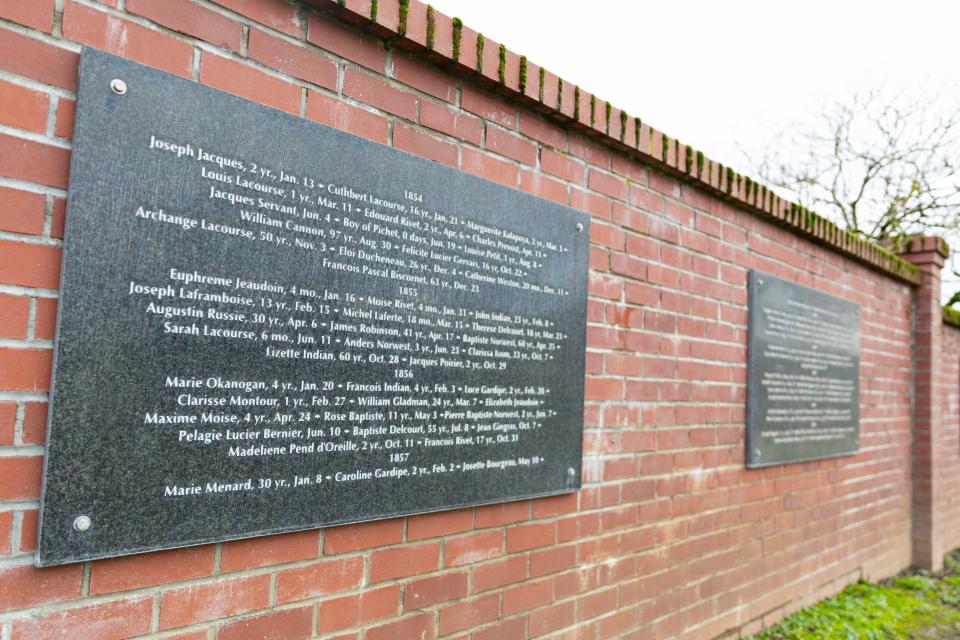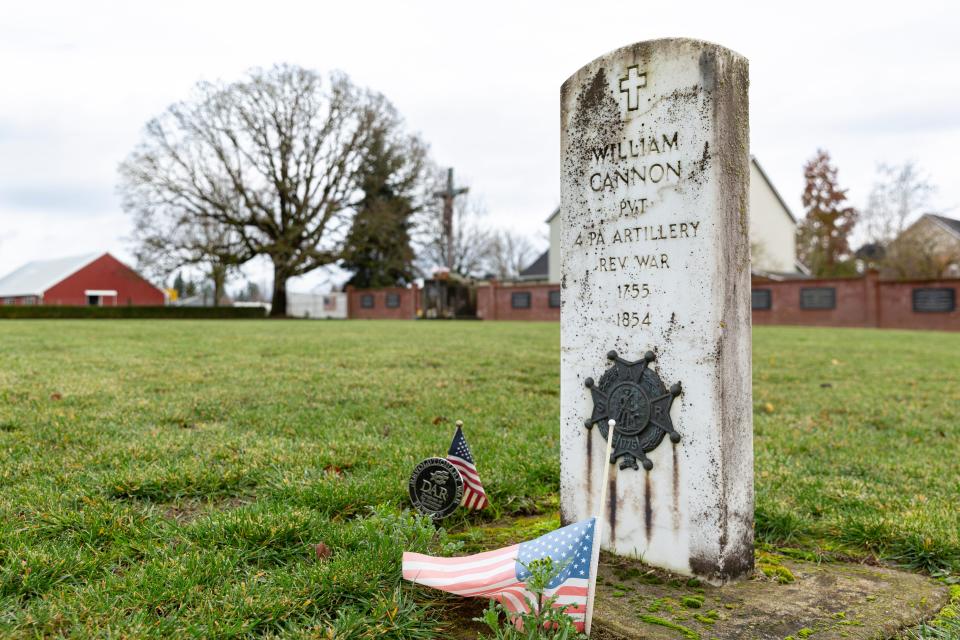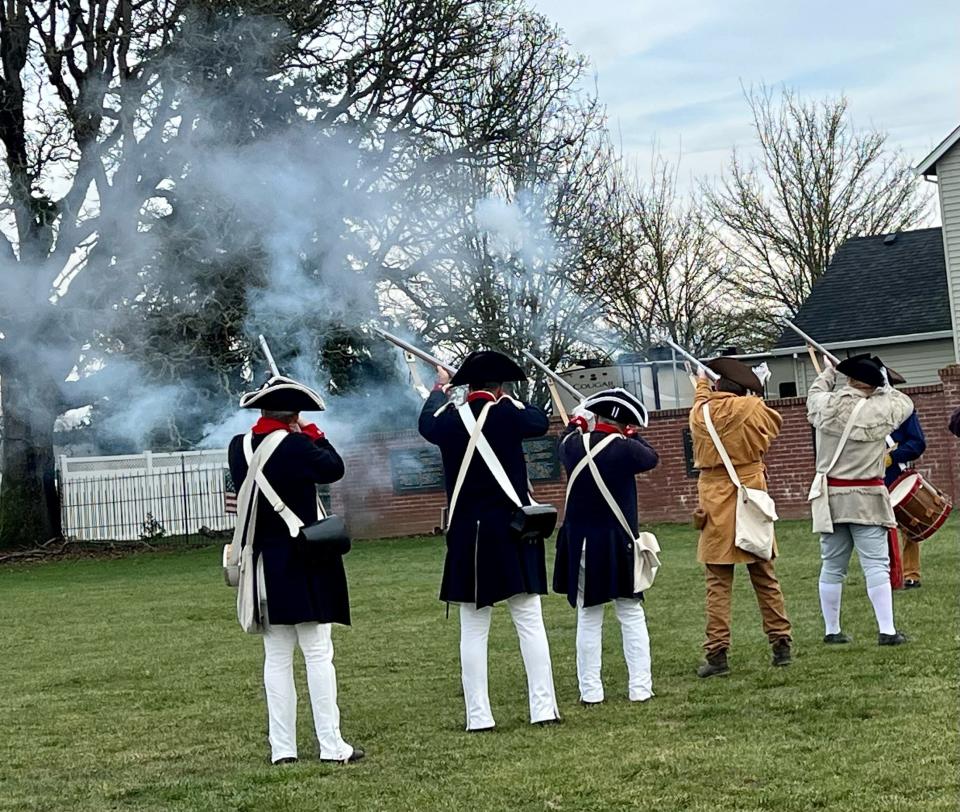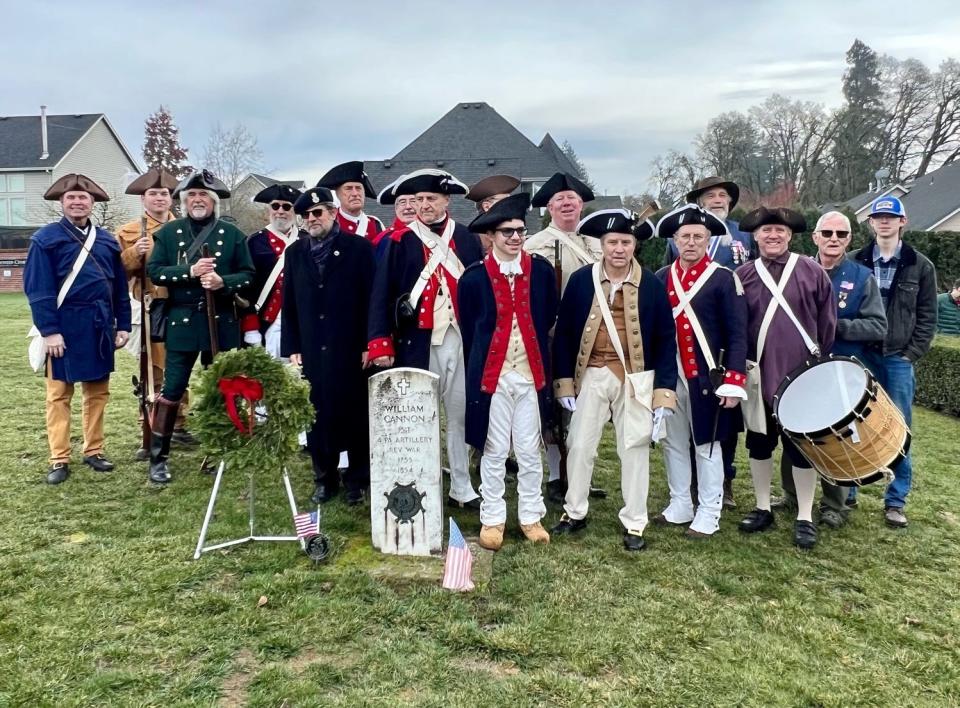Special ceremony held for lone headstone at St. Paul Pioneer Cemetery in Oregon. Why is that?

This is part of a weekly series answering "Why is that?" questions about Salem and the Mid-Valley.
The question: Why do members of the Sons of the American Revolution gather for a special ceremony each year at St. Paul Pioneer Cemetery? We have the answer. But first, a little history.
The background: St. Paul, 20 miles northwest of Salem, is best known for its Catholic heritage, hops and rodeo.
It is at the center of the French Prairie of the Willamette Valley and was one of the first white settlements in Oregon Country, established in about 1829 by French Canadian trappers who worked for the Hudson's Bay Company.
The town was named after the local Catholic church, dedicated in 1839 and reconstructed in 1846 with bricks fired on-site. The church is the oldest brick building in Oregon, according to the Oregon Encyclopedia.
Many of the town's earliest residents were buried at the old church cemetery, now known as St. Paul Pioneer Cemetery. The headstones were bulldozed for unknown reasons in the late 1930s, leaving just a rectangular patch of green grass across from the high school on Main Street.
The cemetery is protected on the perimeter by a hedge in front and on the sides and a brick wall in the back where it borders a housing development.

Plaques were added to the Wall of Remembrance in 2003 with the names of more than 500 early pioneers and Native Americans buried there.
Some remains could have been disinterred and moved to the other church cemetery, established in 1875 just around the corner. But most are believed to have been left behind.
Three historical monuments distinguish the pioneer cemetery. A boulder with bronze plaque names of eight early settlers. A large cross honors Oregon's first Catholic missionary and archbishop, Francois Blanchet. And a marble headstone in the southwest corner commemorates Revolutionary War soldier William Cannon.
Why do the Sons of the American Revolution gather annually in St. Paul?
Cannon's headstone has become an annual destination for the Sons of the American Revolution, who have held wreath laying ceremonies at the "gravesite" since 2016.
Cannon is the only documented Revolutionary War soldier buried in Oregon.
St. Paul Catholic Church records show he died Aug. 29, 1854, and was buried in the cemetery the next day. The records describe him as being 99 and a widower of a Chinook woman.
He is not known to have had any descendants.

Cannon is said to have served with the 4th Pennsylvania Regiment and fought in the battles of Kings Mountain and Cowpens, both critical victories in South Carolina. A search of battle records, including one documenting known regiments involved at Kings Mountain, does not list one from Pennsylvania.
It is possible he served there and his regiment went unrecorded or records could have been lost or destroyed.
In the 1950s, a century after his death, stories in the Statesman Journal cast doubts on Cannon's service. But no one seems to doubt their legitimacy today.
The Sons of the American Revolution and the counterpart group for daughters are particular about documentation for membership. It stands to reason the groups would be about this, too.
After a decades-long campaign, a commemorative headstone for Cannon was placed 20 years ago by the Oregon Department of Veterans' Affairs. It is unknown whether it marks his burial site or whether he could have been among those reinterred at the new cemetery.

Cannon was more than just a Revolutionary War soldier.
He settled in the Oregon Country in 1812, when he was around 57. He had volunteered for an overland expedition and was among those who helped establish the first American settlement at Astoria.
He worked as a millwright at Fort Vancouver and is said to have built the first grist mill in the area in 1828. He later became a justice of the peace for the local government in the Willamette Valley.
Cannon was one of 52 men who voted in 1843 for the Provisional Government of Oregon at the famous meeting at Champoeg. His is one of the first entries you can read about in the 1932 book "Men of Champoeg: A Record of the Lives of the Pioneers who Founded the Oregon Government."
Members of the Daughters of the American Revolution spent three years researching and interviewing pioneers and descendants. The authors mentioned Cannon's remains being moved to the new cemetery in St. Paul around the time it was dedicated in December 1875, although they do not cite a source.
Statesman Journal archives note Cannon's burial location and war service had been authenticated in 1991, offering few details. The Sons of the American Revolution led the campaign to have the grave marked and in 2003, it finally happened. Members attended in period costumes, and a priest blessed the simple marble headstone.

Oh, by the way
The most recent ceremony at Cannon's gravesite was Dec. 17. This one took on added significance in commemoration of the 250th anniversary of the Boston Tea Party.
Area SAR chapters saved a wreath from the previous day's "Wreaths Across America" ceremony at Willamette National Cemetery in Portland.
Members attended in period costume, with a color guard and musket volley in honor of Cannon. Area chapters from the DAR and the Children of the American Revolution and St. Paul city and church officials also participated.
National Wreaths Across America Day took place at more than 4,225 participating locations. Volunteers remembered our nation's heroes by reading their names aloud while placing wreaths on their graves. More than 3 million veterans were honored this year.
Capi Lynn is a senior reporter for the Statesman Journal. Email your "Why is that" questions to her at clynn@statesmanjournal.com.
This article originally appeared on Salem Statesman Journal: St. Paul Pioneer Cemetery holds ceremony for Revolutionary War soldier

